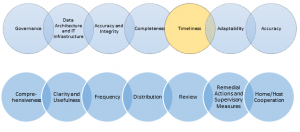 Principle 5:
Principle 5:
Timeliness – A bank should be able to generate aggregate and up-to-date risk data in a timely manner while also meeting the principles relating to accuracy and integrity, completeness and adaptability.
A timely and accurate view of risk exposure, aggregated across credit counterparties and financial products could have helped banks avoid millions of losses at the height of the recent financial crisis. It’s perhaps not surprising then that regulatory bodies have been diligently working to protect banks and the economy from another such event. One example is the release in January 2013 of BCBS 239 “Effective Risk Data Aggregation & Risk Reporting”.
This guidance requires banks to have the ability to generate aggregated and up-to-date risk information in a timely manner, in addition to meeting the requirements of accuracy and integrity, completeness and adaptability. (Read other posts outlining how high-performance analytics can help you meet the requirements of BCBS 239.)
A timely risk data aggregation is still one of the most challenging tasks for many banks. The exact definition of timely risk aggregation can depend on the nature of the business, governance and compliance needs, and overall risk profile of the institution. For example, retail exposures may not change as critically in a short period of time as that for capital market products. However, regardless of the requirements of ‘timing’, a timely risk data aggregation would include risk exposures and cash flows for all asset classes. And this would include derivatives, positions, operating limits, market concentrations, as well as other related liquidity metrics, if available.
In practice, banks often face common issues that can make the aggregation process ‘untimely’:
- There can be vast data sources that need to be processed and consolidated, especially in the case of large banks with global operations and investments. Such institutions will need to achieve risk aggregation and consolidation across different currencies, local rules, time zones, etc. It can be very time-consuming to bring such data together from all different sources, applications, operational and transactional systems, and locations without an integrated data infrastructure.
- The computation complexity, which is often associated with large numbers of risk variables and market states together with complicated instrument pricing functions and models, can make the aggregation process long and manually intensive.
- Stress testing often involves simulating future market states over long future time horizons (e.g., to cover at least five to seven years’ economic cycle at monthly basis). The time required for calculations and aggregation could increase dramatically with the number of horizons.
To address these issues, a financial institution often needs to make significant investment to enhance their data aggregation infrastructure and risk framework. With SAS integrated and high-performance enabled risk management solutions, a bank can more easily overcome these hurdles, achieving their goals for both Basel compliance and business growth with a single platform, and as a result, with a greater return on investment.
Learn more about how SAS can help you address BCBS 239 compliance.
